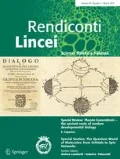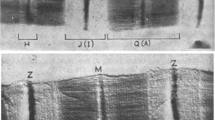Abstract
In March 1902 Emilio Veratti (1872–1967), a pupil of Golgi, published a description of a reticular network in skeletal muscle fibers. The reticulum, as revealed by the «black reaction» consisted of transverse reticula joined by scarce longitudinal elements, corresponding to transverse tubules and sarcoplasmic reticulum, respectively, on account of modern work. Veratti’s work attracted little attention when it was published and was almost forgotten until it was rediscovered in the electron microscope by Stanley H. Bennett and Keith R. Porter who had it republished in an English translation in 1961. The unforeseeable conjunction of important developments in knowledge of excitation-contraction (E-C) coupling in skeletal muscle fibers, leading to the identification of transverse tubules as the anatomical basis for the inward conduction of the excitatory stimulation, was timed to perfection. In particular, locations given to transverse reticula by Veratti, in frog muscle fibers at the Z-line, in mammalian fibers at the A-I boundary, were found corresponding to locations of conductive system based on physiological experiments by A.F. Huxley and R.E. Taylor. It is striking that facts collected with so little guidance from pre-established paradigms still speak with so much clarity to muscle scientists and allows us to see contemporary science as continuous with science at the beginning of the twentieth century. Our debt toward Veratti lies mainly in that.
Riassunto
Emilio Veratti (1872–1967), allievo di Golgi, nel marzo del 1902, pubblicò la descrizione di una forma elaborata di reticolo nella fibra muscolare scheletrica. Il reticolo, come rivelato dalla «colorazione nera», consisteva di un reticolo disposto trasversalmente rispetto alla lunghezza delle fibre, unito da esigui elementi longitudinali, corrispondenti rispettivamente ai tubuli trasversi ed al reticolo sarcoplasmatico, in base agli studi successivi. Il lavoro di Veratti suscitò scarso interesse quando fu pubblicato ed era stato oramai completamente dimenticato, quando venne riscoperto al microscopio elettronico da Stanley H. Bennett e Keith R. Porter, che ne curarono la ripubblicazione in lingua inglese nel 1961. La imprevedibile congiunzione di importanti sviluppi nella conoscenza dell’accoppiamento eccitazione-contrazione che doveva portare alla identificazione dei tubuli trasversi come la base anatomica per la conduzione dello stimolo eccitatorio all’interno delle fibre ebbe a verificarsi al tempo giusto. In particolare, si trovò che la localizzazione del reticolo trasverso basata sulle osservazioni di Veratti, nelle fibre muscolari di rana a livello della banda Z, in quelle di mammifero al limite A-I, era del tutto corrispondente alla localizzazione del sistema di conduzione in base agli esperimenti di A.F. Huxley e R.E. Taylor. Ciò che più colpisce è che fatti, ottenuti senza la guida di paradigmi prestabiliti, tuttora parlino così chiaramente agli studiosi del muscolo e ci consentano di vedere la scienza contemporanea in continuità con la scienza all’inizio del ventesimo secolo. In questo sta principalmente il nostro debito verso Veratti.
Similar content being viewed by others
References
Andersson-Cedergren E., 1959.Ultrastructure of motor end plate and sarcoplasmic components of mouse skeletal muscle fiber as revealed by three-dimensional reconstruction from serial sections. J. Ultrastr. Res., Suppl., I: 1–191.
Berchtold M.W., Brinkmeier H., Muentener M., 2000.Calcium ion in skeletal muscle: its crucial role for muscle function, plasticity and disease. Physiol. Rev., 80: 1215–1265.
Carafoli E., 2002.Calcium signalling: a tale for all seasons. Proc. Natl. Acad. Sci. USA, 99: 1115–1122.
Ebashi S., 1961a.Calcium binding activity of vesicular relaxing factor. J. Biochem., 50: 236–244.
Ebashi S., 1961b.The role of relaxing factor in contraction-relaxation cycle of muscle. Progr. Theor. Phys., 17: 17–35.
Ebashi S., Lipmann F., 1962.Adenosine triphosphate-linked concentration of calcium ions in a particulate fraction of rabbit muscle. J. Cell Biol., 14: 389–400.
Franzini-Armstrong C., Peachey L.D., 1982.A modified Golgi black reaction method for light and electron microscopy. J. Histochem. Cytochem., 30: 99–105.
Hartwell L.H., Hopfield J.J., Laiber S., Mussay A.W., 1999.From molecular to modular cell biology. Nature, 402 (Suppl.): C47-C52
Hasselbach W., Makinose M., 1961.Die Calciumpumpe der «Erschlaffungsgrana» des Muskels und ihre Abhangigkeit von der ATP-spaltung. Biochem. Z., 333: 518–528.
Heilbrunn L.V., Wiercinski F.J., 1947.The action of various cations on muscle protoplasm. J. Cell comp. Physiol., 29: 15–31.
Hill A.V., 1949.The abrupt transition from rest to activity in muscle. Proc. R. Soc., London, Ser. B, 136: 399–420.
Huxley A., 1995.E-C-coupling: the pre-Ebashi era. In:K. Maruyama, Y. Nonomura, K. Kohama (eds.),Calcium as cell signal. Igaku-Shoin, Tokyo-New York: 23–29.
Huxley A.F., Taylor R.E., 1958.Local activation of striated muscle fibres. J. Physiol., 144: 426–441.
Lewontin R., 2000.It ain’t necessarily so. Grant Books, London.
Margreth A., 1999.Playing with the sarcoplasmic reticulum with Giovanni. Ital. J. Neurol. Sci., 20: 367–370.
Margreth A., 2000–2001.Ricordo di Massimo Aloisi. Atti Istituto Veneto di Scienze, Lettere ed Arti, Tomo CLIX, Parte Generale ed Atti ufficiali: 3–24.
Mazzarello P., 1999.The hidden structure: A scientific biography of Camillo Golgi. Oxford University Press, Cambridge (originally published as:La struttura nascosta. Cisalpino, Bologna, 1996. Translated from the Italian and edited by H. A. Buchtal and A. Badiani).
Mazzarello P., Bentivoglio M., 1998.The centenarian Golgi apparatus. Nature, 392: 543–544.
Muscatello U., Andersson-Cedergren E., Azzone G.F., Von Der Decken A., 1961.The sarcotubular system offrog skeletal muscle. A morphological and biochemical study. J. Biophys. Biochem. Cytol., Suppl., 10: 201–218.
Needham D.M., 1971. Machina Carnis.The biochemistry of muscular contraction on its historical development. Cambridge University Press, Cambridge: 331–332.
Porter K.R., 1956.Sarcoplasmic reticulum in muscle cells of Amblyostoma larvae. J. Biophys. Biochem. Cytol., Suppl., 2: 163–170.
Porter K.R., 1961.The sarcoplasmic reticulum. Its recent history and present status. J. Biophys. Biochem. Cytol., 10: 219–226.
Porter K.R., Palade G.E., 1957.Studies on the endoplasmic reticulum. III. Its form and distribution in striated muscle cells. J. Biophys. Biochem. Cytol., 3: 269–300.
Veratti E., 1902.Ricerche sulla fine struttura della fibra muscolare striata. Mem. R. Ist. Lombardo, Cl. Sc. Mat. Nat., 19: 87–133.
Veratti E., 1953.L’interpretazione dei corpi del Negri cinquant’anni dopo la scoperta. Boll. Soc. Med. Chir. Pavia, 67: 1–15.
Veratti E., 1961.Investigations on the fine structure of striated muscle fiber. J. Biophys. Biochem. Cytol., 10 (4) Suppl.: 3–59 (Translated from the Italian by C. Bruni, H.S. Bennett and D. de Koven).
Author information
Authors and Affiliations
Corresponding author
Rights and permissions
About this article
Cite this article
Margreth, A. Our debt toward emilio veratti. Rend. Fis. Acc. Lincei 13, 249–255 (2002). https://doi.org/10.1007/BF02904354
Issue Date:
DOI: https://doi.org/10.1007/BF02904354




